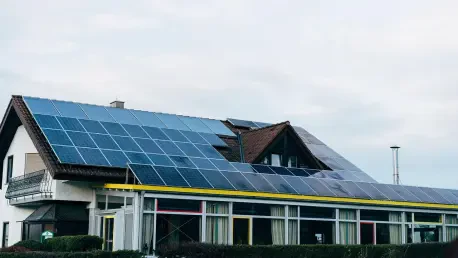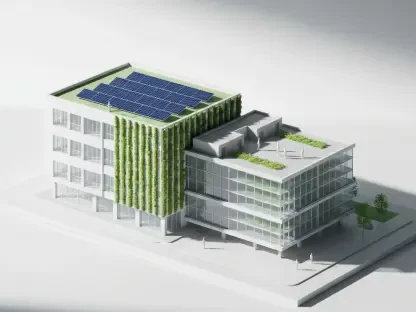In an age focused on sustainability, innovative approaches to construction materials are emerging, challenging traditional methods and minimizing environmental impacts. One groundbreaking development involves transforming human urine into bio-concrete, a revolutionary material that scientists at the University of Stuttgart are exploring. By harnessing waste, they aim to replace conventional concrete, notorious for its detrimental environmental footprint, with more sustainable alternatives. This research marks an innovative stride in construction practices, aligning with broader goals of reducing carbon emissions and promoting eco-friendly solutions. The potential applications of such materials extend beyond buildings, representing a promising cornerstone for sustainable development.
The Impact of Traditional Building Materials
Environmental Concerns with Conventional Concrete
Traditional concrete production poses significant environmental challenges, primarily due to substantial carbon emissions and contribution to environmental degradation. Cement, the central component of concrete, is notorious for its energy-intensive production processes and major CO2 emissions worldwide. The chemical reactions involved in cement production release vast amounts of carbon dioxide, placing the construction industry among the top global warming contributors. As urban development and infrastructure expand rapidly, reliance on conventional concrete only exacerbates the need for sustainable alternatives. Addressing these concerns necessitates innovative approaches that reduce emissions and reflect evolving principles of construction material production.
Urgency for Sustainable Alternatives
Given the immense environmental impact of conventional building materials, there is a growing call for the construction industry to transition towards sustainable practices. The quest for materials that minimize environmental harm and carbon footprints has intensified, prompting researchers and professionals to pursue greener alternatives. Substitutes for cement are particularly interesting as they promise to reshape sustainable construction practices. Developing sustainable materials addresses environmental concerns and fosters an industry-wide shift toward eco-friendly methods, influencing economic models, resource utilization, and societal values in the long term. By finding viable alternatives, proponents of sustainable construction aim to lower emissions and redefine the narrative around building materials.
Innovative Research from the University of Stuttgart
Transformative SimBioZe Project
Enter the transformative SimBioZe project, where innovation meets sustainability as researchers pioneer an inventive approach to transforming human urine into bio-concrete. At the core of this project lies the unique utilization of microbial processes, where bacteria act to solidify sand using calcium carbonate derived from urea in urine. This biotechnological method showcases waste byproducts becoming valuable resources, representing a paradigm shift in construction material practices. It offers a perspective on reducing waste by transforming it into a constructive force that reimagines conventional building materials. As the world increasingly embraces circular economy principles, the SimBioZe project epitomizes the alignment of science and sustainability.
Promising Preliminary Findings
Initial experimental findings related to bio-concrete show that it can achieve impressive compressive strengths, surpassing 50 megapascals when technical-grade urea is used. Such strength metrics are adequate for various construction applications, giving researchers hope for wider adoption. Nonetheless, challenges have surfaced when human-sourced urine is used, as it results in lower strength due to diminished bacterial activity. Tackling these obstacles requires continued experimentation and refinement, with scientists optimistic about future improvements to make bio-concrete feasible for broader usage. Optimizing bio-concrete’s properties represents a pivotal stride toward eco-friendly construction, driving a narrative of waste transformation and sustainable building practices.
Future Applications and Plans
Expanded Experimentation Endeavors
The forward-looking experimentation led by researchers features strategic plans to conduct trials at Stuttgart Airport, an initiative poised to elevate the practicality of bio-concrete production. Here, urine collected from public restrooms is planned for transformation into both bio-concrete and fertilizer, highlighting a dual-purpose strategy addressing construction and agricultural needs. This endeavor reflects a consolidation of scientific and environmental objectives and showcases a commitment to creating impactful applications for waste materials. The vision for bio-concrete encompasses its use in agriculture, offering a broader horizon where sustainability benefits extend beyond buildings to support ecological cycles and contribute to food security.
Circular Economy and Waste Utilization
Aligning with circular economy principles, the approach to utilizing waste products, such as human urine, for construction and agricultural purposes heralds a new era in material usage. The circular economy emphasizes reusing, recycling, and minimizing waste, presenting a pathway that significantly diminishes environmental impacts. Reimagining waste as a resource, this methodology challenges entrenched norms and fosters a shift from traditional, resource-intensive practices to sustainable and innovative utilization. Such practices promise reduced dependence on raw materials, lower emissions, and enhanced resource efficiency, shaping a constructive narrative around waste and weaving it into the fabric of sustainable architectural advancements globally.
Societal and Environmental Advocacy
Encouraging Public Involvement
The scope of sustainability transcends scientific research, reaching into societal fields to encourage active involvement from individuals. By adopting sustainable lifestyle choices, individuals can significantly contribute to fostering an environmentally conscious society. Reducing meat consumption and supporting circular fashion may seem distant from construction, but these actions cumulatively reduce environmental footprints and champion sustainability beyond specific industries. Encouraging public participation frames a collective mission toward ecological stewardship, reflecting broader societal values of accountability and shared responsibility in pursuit of a healthier planet. As individuals integrate sustainable practices into daily lives, they represent a formidable force in advocating for societal transformations.
Empowerment through Advocacy
A groundbreaking experiment led by researchers aims to revolutionize bio-concrete production through strategic trials at Stuttgart Airport. This initiative plans to utilize urine collected from public restrooms to produce both bio-concrete and fertilizer, showcasing a dual-purpose approach that addresses construction and agricultural needs. By focusing on recycling waste materials, the project highlights a merging of scientific innovation with environmental responsibility. The vision extends beyond traditional applications, envisioning bio-concrete as a catalyst for agricultural growth and ecological benefits, thereby enhancing food security. This forward-thinking strategy underscores a commitment to sustainable practices, demonstrating how waste can transform into valuable resources that support ecological cycles. The project at Stuttgart Airport serves as a testament to how innovative approaches can significantly contribute to both infrastructure and the environment, offering solutions that transcend conventional boundaries to deliver tangible societal benefits.









